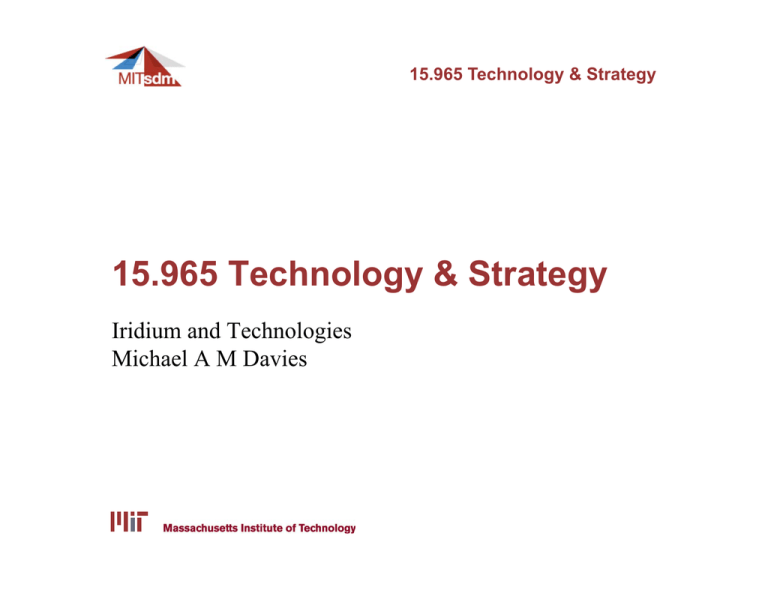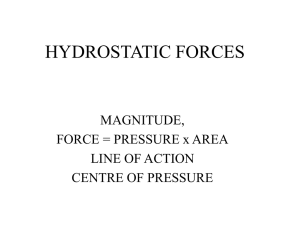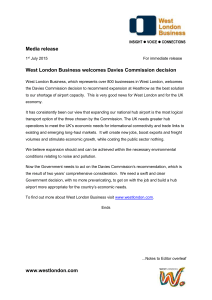Document 13457132
advertisement

15.965 Technology & Strategy 15.965 Technology & Strategy Iridium and Technologies Michael A M Davies 15.965 Technology & Strategy Agenda for today ~13:00 ~13:45 ~14:15 •� Iridium •� Technologies •� Logistics –� Projects session next week –� First individual paper 15.965 Technology & Strategy Iridium was technically successful, but a commercial disaster – what can we learn from it? 1.� Who is responsible for Iridium’s failure? 2.� At what point could you have predicted out that there was a significant risk that Iridium would fail? 3.� What is your assessment of Iridium’s overall system design? 4.� What impact did the choices that were made have on the subsequent economics of the venture? 5.� What impact did Iridium’s organization design have on the outcome, and in particular who were the key stakeholders and what was their motivations? 6.� What alternative technical or commercial strategies could or should Iridium have pursued? 15.965 Technology & Strategy Importance of decisions and timing •� Early decisions critical – impose constraints, set trajectory –� influenced by framing: “A truly global phone system” –� often made before project starts, implicit! •� Early decisions are “sticky” – hard to change –� sunk cost fallacy –� system architecture: “by-pass” versus “bent pipe” •� Initial assumptions often wrong – context can change –� terrestrial cellular coverage inadequate… –� international calling to home is lucrative… Michael A M Davies 15.965 Technology & Strategy Low Earth Orbit (LEO) satellite constellation concept Comsat i Comsat i + 1 Intersatellite link (ISL) Return link Forward link Feeder uplink Orbital altitude h Terminal uplink Feeder downlink Terminal downlink εmin Gateway End user terminal PSTN Cellular Image by MIT OpenCourseWare. Michael A M Davies 15.965 Technology & Strategy Global coverage and diversity Image by MIT OpenCourseWare. Polar constellation� Walker constellation� •� global coverage� •� population coverage� •� less diversity� •� less diversity� Michael A M Davies 15.965 Technology & Strategy Who was doing the design? What was the context? •� Customers –� cellular works well enough •� Local PTTs –� nationalized, large source of revenues –� licenses required to operate telecom service •� Motorola Space Systems Group –� transition from military –� bootleg project –� limited (at best) contextual knowledge Michael A M Davies 15.965 Technology & Strategy Alignment: design must fit context Customers and applications Demand Opportunity Ecosystem Enterprise Business Ecosystem Technological Infrastructure Entrepreneur Technology Innovation trajectory Michael A M Davies 15.965 Technology & Strategy By 1995 (pre-launch) US cellular subscribers were way ahead of 1991 projections (announced) Michael A M Davies 15.965 Technology & Strategy Adaptation: things change •� Now have local gateways – so why “bypass” architecture? •� When could you have known that Iridium would fail? –� capital spend ramps in 1996 –� 1st satellite launched in 1997 –� prospects for cellular growth were right by 1995 •� BUT who was going to pull the plug? –� Motorola: prime contractor, but only 20% of the equity –� other equity participants: limited skills, money in game –� financiers: strongest incentives, weakest ability… Michael A M Davies 15.965 Technology & Strategy What would flexibility look like? •� Could Iridium have had earlier feedback? –� what kind of project “milestones” could they have used? •� Technical experiments –� single satellite to test coverage in buildings, cities –� two satellites to test communication links between them •� Market experiments (??) –� skew orbits to serve target test market first –� even if only one area – what info would they get? Michael A M Davies 15.965 Technology & Strategy The $5 billion question: Why did they not think like this •� Cognitive biases that influence perceptions of risk –� over-optimistic (means are biased upwards) –� over-confident (under-estimate variance in outcomes) •� Ex-post managerial reactions to experiments that fail! •� The cost (and time) required to conduct early experiments are salient, but the information generated is hard to value –� costs: tangible, occur NOW, impact specific budget –� benefits: subtle, intangible (info), in future, different part of the organization Michael A M Davies 15.965 Technology & Strategy Closing thoughts •� Big Bang projects usually blow up •� For most opportunities from technology-driven settings: not enough customers who care enough •� “Most complex projects in an uncertain environment can be broken down into a series of smaller experiments, the value of which will exceed their cost.” 15.965 Technology & Strategy Technologies and technological innovation •� Technologies emerge –� can be push - supply, driven by new knowledge - or pull - demand, driven by demand opportunity •� Learning takes place –� either or both of over time, or as a result of accumulated experience –� driven by what’s possible - technological feasibility - and by what’s worthwhile - commercial viability •� Over time, performance improves and unit costs fall –� along which parameters –� at what rate –� locally, or causing system change Michael A M Davies 15.965 Technology & Strategy Parameter noun 1.� one of a set of measurable factors…that define a system and determine its behaviour…1 2.� a factor that restricts what is possible or what results1 3.� a distinguishing characteristic or feature1 1: American Heritage® Dictionary, © 2000 Houghton Mifflin Michael A M Davies 15.965 Technology & Strategy Technology envelopes and trade-offs Parameter x Trade-off Parameter y Technologies are characterized by performance envelopes, the limits of what can be done with them, and the trade-offs amongst parameters for them� Different technologies have different envelopes and trade-offs� Michael A M Davies 15.965 Technology & Strategy Trade-off noun 1.� the exchange of one thing for another of more or less equal value, especially to effect a compromise1 2.� an exchange of one thing in return for another, especially relinquishment of one benefit or advantage for another regarded as more desirable1 1: Random House Unabridged Dictionary, © Random House Inc. 2006� 2: American Heritage® Dictionary, © 2000 Houghton Mifflin� Michael A M Davies 15.965 Technology & Strategy Envelope noun 1.� the technical limits within which an aircraft or electronic system may be safely operated1 2.� the maximum operating capability of a system (especially an aircraft)2 1: Random House Unabridged Dictionary, © Random House Inc. 2006� 2: WordNet®, © 2005 Princeton University� Michael A M Davies 15.965 Technology & Strategy Technologies compete with each other for potential applications •� At any time, there are typically a range of competing technologies that are candidates for each application •� Each of these technologies can be characterized in terms of its key parameters •� Each technology typically has a performance envelope, which defines the trade-offs inherent in the technology •� Over time, technologies follow an innovation trajectory, a vector or function that describes how they have evolved and may evolve, either over time or in response to effort invested in their development –� rate of change –� direction Michael A M Davies 15.965 Technology & Strategy Innovation trajectories Performance Performance tends to be ultimately constrained by physical limits although these may be a long way off, or not relevant to what customers want done� Time Michael A M Davies 15.965 Technology & Strategy Innovation trajectories Performance Performance is often a � non-linear function of effort invested, with rapid progress during rapid growth, slow improvement in maturity, and sometimes slowdowns� Cumulative Effort Michael A M Davies 15.965 Technology & Strategy S-curves in the rigid disk drive industry Image removed due to copyright restrictions. Clayton Christensen, “Exploring the Limits of the Technology S-Curve - Part I: Component Technologies”,� Production and Operations Management, Fall 1992, pages 334-357� Michael A M Davies 15.965 Technology & Strategy Within this smooth overall progression, individual businesses went slower or faster 40 30 Areal density 20 15 10 8 6 5 4 3 Control data Fujitsu 2 1 76 77 78 79 80 81 82 83 84 85 86 87 88 (Densities in millions of bits per square inch) Image by MIT OpenCourseWare. Clayton Christensen,� “Exploring the Limits of the Technology S-Curve� Part I: Component Technologies”,� Production and Operations Management, Fall 1992, pages 334-357� Michael A M Davies 15.965 Technology & Strategy The rate at which performance improves can vary dramatically Yearly improvement index 100,000 90,000 80,000 100 90 80 70 60 50 40 30 20 10 0 PCs Digital cameras Personal stereos 0 1 3 Vacuum cleaners 5 7 9 11 13 15 17 19 21 Years from product launch Image by MIT OpenCourseWare. Fernando Suarez and Gianvito Lanzolla, “The Half-Truth of First-Mover Advantage”,� Harvard Business Review, April 2005, pages 121-127� Michael A M Davies 15.965 Technology & Strategy Technology assessment Identify the key parameters that characterize the technology – performance and cost – trade-offs and envelope For each of the key parameters, assess how these will likely evolve over time – innovation trajectory – timing and risks� Identify and objectively � benchmark alternative technologies � – both established � and emerging� Assess the technical system(s) which this technology can potentially deployed as an element of Consider the systemic implications of this technology, its impact on overall system performace� Identify potential applications, and the key requirements for those applications� Synthesize this information to identify whether or not a technology is likely to be successful – invested in or widely adopted – or to evaluate the appropriate technology choice for your particular application � Michael A M Davies 15.965 Technology & Strategy First individual assignment •� Why is this technology and domain interesting and important, what makes it significant and worthy of focus? •� What are the key parameters that characterize it, what are the key trade-offs and the performance envelope? •� How have the key parameters evolved over time, what has been the innovation trajectory for this technology? •� What are the key alternative technologies with which it competes for potential applications, and what are their advantages and disadvantages? •� How do you anticipate the key technologies in this domain are likely to evolve, and are they likely to be subject to “natural technological limits”? Michael A M Davies 15.965 Technology & Strategy The first individual assignment is due on Lecture #5 •� Must not be longer than a maximum of 2,000 words –� about four (4) pages long –� excluding tables or figures (which are encouraged) –� 1.5 line spacing, 10 to 12 point (10-12pt) font –� 1 inch or greater (�1”) margins all round •� Filename must have the following format: ‘15.965­ firstname-lastname-paper 1’ •� If you don’t know how, figure it out now 15.965 Technology & Strategy If you submit a paper late, your mark for that paper will be reduced by a simple sliding scale •� As of 09:00:00 an 8% discount, scaling the mark for that paper by 92% •� Thereafter an additional 4% per hour that the paper is late, so that a paper that is just over an hour late will be subject to a 12% discount, scaling the mark for that paper by 88% •� As a result, a paper that is one day, twenty-four hours, late will earn a zero mark Michael A M Davies MIT OpenCourseWare http://ocw.mit.edu 15.965 Technology Strategy for System Design and Management Spring 2009 For information about citing these materials or our Terms of Use, visit: http://ocw.mit.edu/terms.

